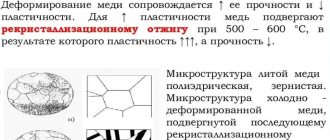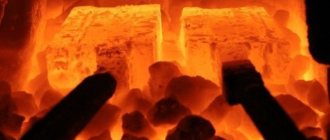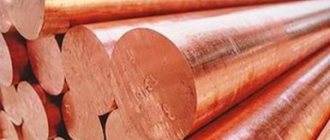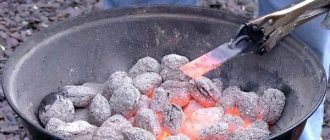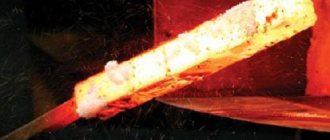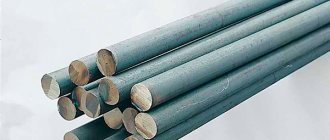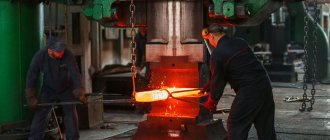In this article we will cover the following sections:
- Hardening
- Annealing
- Normalization
- Vacation
Thermal or heat treatment of metals is a set of processes such as holding and cooling a solid metal alloy in order to improve the characteristics of the product. The transformation of grade 45 steel itself will occur due to changes in its internal structure.
How does the further operation proceed in detail? If you heat special structural steel 45 to high temperatures (720 °C), you can notice a change in the crystal lattice of the metal. It transforms from a body-centered to a face-centered structural type.
So, heat treatment includes these types of mandatory procedures.
- hardening
- annealing
- normalization
- vacation
Structural changes in metal
When heating special structural steel 45 to the austenitic level, the state of the structural lattice of iron changes with a transition from a body-centered to a face-centered structure. The carbon included in pearlite and representing the smallest crystals of Fe3C (cementite) moves into a face-centered modified iron lattice.
Structure of steel 45 after annealing and hardening
During cooling, the temperature of the steel being processed rapidly decreases, but due to the slowdown in the speed of movement of carbon atoms, they remain embedded in the new iron lattice, forming a solid supersaturated structure with internal stress. The lattice is transformed into a tetragonal lattice with orientation in one direction.
The formation of needle-shaped small structures called martensite occurs. This type of crystal gives the metal high strength, hardness and improved characteristics. Two types of austenite and martensite crystals are simultaneously formed, which act on each other, creating internal excess stress. When external forces actively influence the metal, mutual compensation of the two types of crystals occurs, imparting strength to the structure.
Diffusion annealing
According to industry norms, this type of heat treatment can be classified as extreme. The metal is heated to the highest possible temperature, exceeding critical points. The technology is often used for alloys with complex and low-melting compounds. At the same time, the structure of hypereutectoid steel after annealing becomes less hard and much more ductile, which allows the use of a wide range of techniques for further processing. The method requires full control and adherence to technology, since there are high risks of overheating and burnout, which can lead to partial or complete loss of the necessary qualities and such metal will be unsuitable for further operations. The exact temperature for complete annealing of hypoeutectoid steel and other grades of metal is available in special reference books.
Heat treatment of metal
To change the characteristics of steel, heat treatment is carried out in compliance with the necessary exposure modes.
The heat treatment process consists of the following processes:
- annealing;
- normalization;
- aging;
- hardening and tempering.
Heat treatment modes for steel 45
Hardening and tempering of steel largely depends on a number of factors:
- temperature conditions;
- rate of temperature increase;
- time period of exposure of metal to high temperatures;
- cooling process (rate of change in cooling temperature of a medium or liquid).
Types of annealing
It is customary to divide this operation into two main types. Annealing of steel can be of the 1st and 2nd type. In the first case, phase recrystallization does not occur, but the metal acquires the desired qualities. The consequences of mechanical processing of metal in rolling mills and dies are eliminated.
Hardening of the steel surface after physical impact at a metallurgical plant is called cold hardening.
The main purpose of annealing steel of the 1st type is to reduce strength and increase ductility necessary for further processing. Partial recrystallization reduces internal stresses, which makes products more reliable and durable.
Annealing of type 2 steel is characterized by dramatic changes in the structure. Phase recrystallization is achieved by heating the metal above critical points and precisely implementing the cooling regime in temperature and time. These types of annealing and their purpose are determined by production tasks to obtain the necessary qualities of the metal. Critical temperatures are a serious risk factor. In some cases, for example, when burned, irreversible changes in the structure occur. This metal is sent for smelting. Heat treatment, annealing and normalization of steels is a complex process that makes it possible to obtain products from initial raw materials that meet the requirements of manufacturers of final products according to the specified characteristics.
Steel hardening
The steel hardening process involves heat treatment of workpieces with heating to a temperature above critical with further acceleration of cooling. This condition helps to increase the strength and hardness (HRC) of steel while reducing ductility and improving consumer characteristics.
The mode of influence of the metal cooling temperature depends on the amount of carbon content and alloying additives in the steel.
After hardening the steel, the workpieces are covered with a coating of scale and partially lose the carbon they contain, so the technology must be followed in accordance with the established regulations.
Cooling of the metal must occur quickly to prevent the transformation of austenite into sorbitol or troostite. Cooling must be carried out exactly according to the schedule; rapid cooling of the workpieces leads to the formation of small cracks. During the cooling process from 200 °C to 300 °C, an artificial slowdown occurs as the products gradually cool down; for this, coolants can be used.
Steel cementation - the essence of the process
The chemical-thermal method of processing steel is a change in the composition of the material in a certain layer. It is this method that steel carburization refers to. At its core, this steel processing process consists of enriching its surface with a certain amount of carbon when heated in a certain chemical environment. Using this technique, a product with a set of very useful properties - a hard surface layer on a soft inner one. Thus, the soft core layer resists impacts quite well, and the outer layer of the part, on the contrary, has good hardness and increased wear resistance. An ideal combination that allows parts made using this method to work for a long time and be very reliable.
The process of steel carburization is especially effective in cases where it is low-carbon types that are enriched. As a rule, such a metal contains no more than 0.2% carbon. However, for medium-carbon steel grades this procedure also brings positive results. The technological process is relatively simple: a special environment is created in a special chamber, capable of releasing a large amount of active carbon when heated to a certain temperature (approximately in the range from 850°C to 950°C). It should be noted that steel carburization is a rather lengthy technical process . Typically, the saturation rate of a metal surface, at which it acquires specific properties, is approximately 0.1 mm per hour. For high-quality processing of the product and its reliable operation, a cementitious layer of approximately 0.8 mm or more is required. And, therefore, for effective carburization of steel it will take at least 8 hours. The main media (or carburizers, as they are also called) for this process are:
- solid medium;
- gas environment;
- pasty medium;
- a medium consisting of electrolyte solutions;
- fluidized bed
Hardening steel using HDTV
When carrying out surface hardening using high-frequency frequencies, the process of heating products is carried out to a higher temperature.
This is caused by two factors:
- Heating is carried out in a short time with accelerated change and transition of pearlite to austenite.
- The transition reaction must be carried out in a short time within a short period of time at high temperature.
Hardening with high-frequency currents
The processes occurring during conventional hardening in a furnace using high-frequency frequencies have different characteristics and lead to a change in the hardness (HRC) of the workpieces:
- When heated in an oven, the speed is 2-3 °C/sec up to 840 – 860 °C.
- Using HDTV - 250 °C/sec to a temperature of 880 - 920 °C or in mode at 500 °C/sec - up to 980 - and 1020 °C.
When using HDTV, parts are heated to a higher temperature, but the workpiece does not overheat. In the process of processing using HDF, the heating operation time is significantly reduced, which helps maintain grain size and structure. During the high-frequency hardening operation, the metal hardness (HRC) increases by 2-3 units. according to Rockwell.
Application of protective measures
During the heat treatment process, carbon gradually burns out and scale forms. To prevent deterioration of the quality of the metal and protect it, shielding gases are used, which are pumped during the hardening process. Ammonia or methane gas is pumped into the furnace, which has a sealed chamber, where heat treatment occurs using a special generator.
In the absence of sealed furnaces, processing operations are carried out in a special sealed container, into which cast iron shavings are first poured to prevent carbon burnout.
When processing workpieces in salt baths, the metal is protected from oxidation, and to create the necessary conditions for maintaining the carbon level, the contents of the bath are deoxidized 2 times during the day with boric acid, blood salt or borax. At processing temperatures in the temperature range of 760-1000 °C, charcoal can be used as a deoxidizing agent.
Full, partial annealing
Heat treatment is used to achieve the required qualities of the metal. The purpose of steel annealing is defined as obtaining specified technological properties. They can be both general and quite specific. Thus, incomplete annealing of hypereutectoid steel is acceptable in the manufacture of structural elements, but in the production of parts with specified characteristics it will be insufficient. Changes in the metal structure in both types of processing are different. Not only the annealing time of the steel plays a role, but also the temperature. An important factor in successfully solving the problem is the cooling mode.
Complete annealing of steel
When steel is not completely annealed, the temperature does not reach the upper critical point. The requirements for cooling time are also less stringent. When performing complete annealing of steels, the metal is heated above the critical point. Then the specified time is maintained and the cooling schedule is accurately followed. When heat treatment and annealing, it is important to take into account the grade of raw materials, hardness, and chemical composition, since the technology and modes are determined by GOST standards.
Use of special coolants
During the technological process, water is mainly used to cool parts. The quality of the coolant can be changed by adding soda or special salts, which can affect the cooling process of the workpiece.
To preserve the hardening process, it is strictly forbidden to use the water contained in it for extraneous operations. The water must be clean and have a temperature of 20 to 30 °C. It is forbidden to use running water to harden steel.
Composition of mixtures of salts and alkalis used as quenching media
This hardening method is used only for cemented products or those with a simple shape.
Products with complex shapes made from special structural steel are cooled in a 5% caustic soda solution at a temperature of 50-60 °C. The hardening operation is carried out in a room equipped with exhaust ventilation. Mineral oils are used to harden workpieces made of high-alloy steel, and the cooling rate in an oil bath does not depend on the oil temperature. Mixing oil and water is unacceptable, as this can lead to cracks in the metal.
When quenching in an oil bath, a number of rules must be followed:
- Be careful not to ignite the oil.
- When the metal cools in the oil, harmful gases are released (exhaust ventilation is required).
- Plaque forms on the metal.
- Oil loses its properties when intensively used to cool metal.
When carrying out the hardening process of steel 45, it is necessary to follow the technological process in compliance with all operations.
In what environment is steel carburization possible?
The hardening process takes place under various environmental conditions:
- in solid;
- in gaseous;
- in an electrolyte solution;
- in the form of a special paste;
- in a fluidized bed.
steel is carburized with graphite in a home workshop . This greatly simplifies the process, since there is no additional need to worry about the strong seal of the oven.
In industrial production, gas is most often used, since this method reduces the time spent on hardening.
Steel tempering 45
The technological process of steel tempering is carried out depending on the required temperature:
- in ovens with forced air circulation;
- in special baths with saltpeter solution;
- in oil baths;
- in baths filled with molten alkali.
The temperature for the tempering process depends on the grade of steel, and the process itself changes the structure and helps reduce the stress of the metal, and the hardness decreases by a small amount. After all operations, the workpiece is subjected to technical control and sent to the customer.
When hardening and tempering metal at home, it is necessary to strictly observe the technology and safety precautions for carrying out work.
General information
In the old days, axes made of raw iron were placed in a sealed clay pot filled with coal and placed in an oven for several days. The outer layers were saturated with carbon under the influence of heat. The tool received a hard surface while maintaining a soft, plastic core. The essence of the technology was preserved, the technique was developed, became widespread and was divided into several branches.
The carburization method is described as a method of processing metal using high temperatures in the environment of certain chemicals (chemical-thermal treatment); the medium can be liquid, gas or solid. Chemical components release free carbon when heated. The surface of the heated metal absorbs gas atoms, changing its structure (diffuse saturation occurs to a depth of 0.5 to 2 mm).
Cementation is applied to parts that are exposed to abrasion and experience vibration and shock during operation. The purpose of such heat treatment is to change (strengthen) some characteristics of the surface layer of a metal product:
- The layer is strengthened, its properties such as hardness and wear resistance are improved; at the same time, the deeper layers retain their original properties (viscosity and elasticity). The surface resists abrasion well, the core is able to withstand dynamic loads.
- After processing, the object acquires a hardness similar to that obtained using the classical hardening method (fire and mechanical stress).
The following features of the method are distinguished:
When organizing the cementation process, it is important to maintain time and temperature intervals. The optimal atomic carbon density appears when the temperature is maintained between 850 and 950°C. Diffuse saturation occurs at a low speed; this is its peculiarity
The surface absorption of gas atoms flows at a speed of 0.1 mm/hour (the value may vary slightly depending on the environment and temperature). Considering that the expected layer thickness starts from 0.8 mm, it is easy to calculate that the part will acquire useful properties in at least 8 hours. The method is found effective for alloy (tool) and low-carbon steels, where the proportion of carbon in the composition is limited to 0.2-0.25%, and they are capable of absorbing an additional number of gas atoms. Machine-building, construction and reinforcing steel grades 20x, 40x are allowed. Carbon steels are not processed in this way. Cementation technology allows the use of several media. Hardening techniques have been developed in the presence of a solid and gas carburizer (a carbonaceous substance capable of dividing carbon). Surface carburization is possible in a fluidized bed, in electrolyte solutions and in pastes.
The most common in production cycles are gas and solid carburizers.

